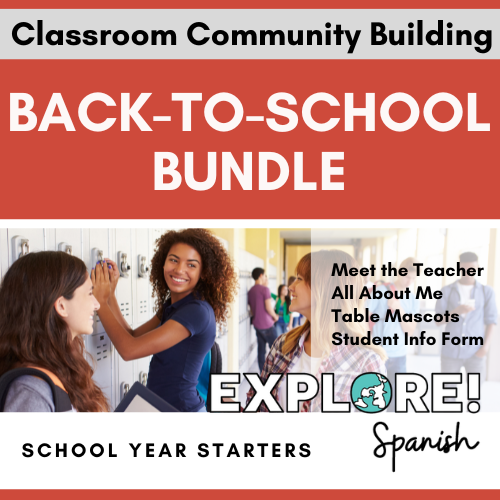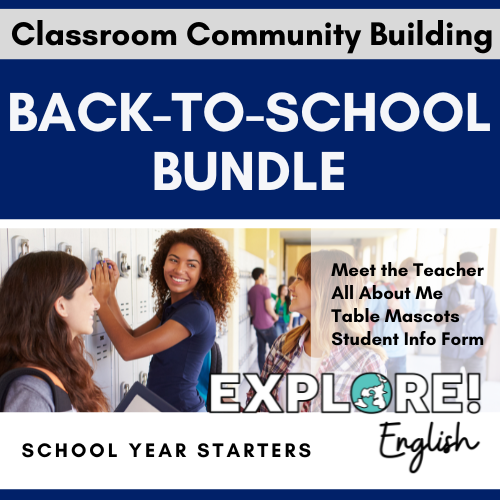6 Strategies for Creating a Classroom Community
Ideas to foster a supportive classroom atmosphere, laying the foundation for collaborative learning and world language speaking proficiency
A few years ago, as my students were working on a group project, I had a realization that changed my teaching practice. Kids were supposed to share a Google Doc with their group mates, but they couldn’t - they didn’t know their partners’ names! This was in October after students had been with the same groups for several days! How could this be?
I’ve always tried to create a collaborative classroom. A wide body of research shows students learn better when they collaborate in a caring, warm classroom community, which promotes soft skills like communication, conflict resolution, leadership, openness to new viewpoints, and patience. Decades of research have repeatedly demonstrated improved academic outcomes for collaborative teaching methods (see research studies here and here, for example).
“ A lot of students need more than opportunities to collaborate - they need tools, practice, and motivation to polish these soft skills.”
So, I seated my students in groups and required them to work together on activities large and small. I took it for granted that these opportunities were resulting quality collaboration - and to some degree, they were. Unfortunately, a lot of students need more than opportunities to collaborate - they need tools, practice, and motivation to polish these soft skills. Thus, creating a true community and effective collaboration in your secondary classroom doesn’t happen by accident! It requires intentional planning, clear structure, and ongoing maintenance.
Here are a few tips and considerations for fostering effective group work, collaboration, and general congeniality among your students.
Start on day 1...
Building anything great takes teamwork.
… and build collaborative learning into your first week of school. The beginning of school sets student expectations for what is to come. If you want students to develop relationships and participate in groups, don’t ask them to sit passively through the first lesson while you deliver information about the syllabus! Instead, give them a fun, collaborative task and start setting expectations that in this class, we work together toward engaging, valuable learning outcomes. My School Year Starters product line on my Teachers Pay Teachers store is a great place to start! Back to School activities are available in Spanish, French, ELL, and Portuguese
Build community into your classroom rules
If classroom community is a priority, articulate those expectations in your classroom rules, and refer to them regularly as conflicts arise. I have had good success with these 3 rules:
“Classroom Rules:
Rule #1 Be kind.
Rule #2 Do your best work.
Rule #3 Have fun.”
I’ve found that these three rules cover most any academic or social conflict that arises in my secondary classroom. The rules are in order of importance, so if there’s a situation where two rules come into conflict (“Have fun vs. Be kind, for example), the lower number rule takes precedence. As class moves forward, any time an interpersonal conflict arises I remind students, “Rule #1!” “Rule #1 quickly becomes a motto in our classroom, and students take delight in reminding each other of its importance - just in case their classmates forget!
Find rules that work for you, and use them as a tool to ground students in the social behaviors you want to cultivate. Rules like “Be kind” are appropriate even for high schoolers and cover a wide range of situations that can arise as teenagers negotiate relationships with their peers - and with you.
Teach and practice expectations for group work
“Don’t assume your students - even high school students - really know how to collaborate.”
Don’t assume your students - even high school students - really know how to collaborate. Take the time to think through what good collaboration looks like in your classroom, and explicitly teach these expectations. Direct teaching followed immediately by practicing the desired skill is appropriate. I like using case studies to spark discussion about desired behaviors. If, at any point in the class, you find students are not collaborating as you desire, the answer is usually “more structure”. Contemplate exactly what you want students to do, and take the time to teach and practice these behaviors.
Play Teacher vs. Class games
Pitting yourself against the entire class in a trivia game or skills-based competition is an extremely powerful tool in creating group cohesion. Every year in my level 1 classes I play a logic game using the numbers up to 20. Here’s a video of me explaining this game to a Spanish student (and then beating him)!
The secret to this game is knowing the key numbers: 3, 7, 11, 15, and 19. At any point if I erase one of these numbers, I have taken control of the game and guarantee I’ll win. I keep a running tally on the board as I beat the class again and again over several class periods until - eventually - a student figures out the trick. Often, the entire class will erupt in cheers for their hero-classmate. This game reinforces content, is super-fun, and goes a long way to solidifying students as a team.
Experiment with different types of groups
“Often, weaker students are quite intimidated by their peers, and in working with classmates of similar ability may feel freer to participate.”
Teachers often pair weaker students with high-fliers, hoping the stronger student will help the weaker one along. As often as not, the opposite happens: the weak student coasts and the strong student does all the work, without really being challenged. Peer tutoring has its place, but peers should not be made responsible for a classmate’s progress - that’s my job! Instead of automatically establishing heterogeneous ability groupings, experiment with putting students of similar abilities together - at least some of the time. Often, the top students will challenge each other to go deeper with course content. Interestingly, I’ve had good outcomes with pairing weaker students together as well; sometimes these kids are actually quite intimidated by their peers, and in working with classmates of similar ability level may feel freer to participate. This is especially effective when the groups know they will be responsible to share with the full class.
Assessing Group Assignments
Assessing group work is particularly challenging for teachers and is fraught with pitfalls. How do we ensure we are grading actual student mastery, when the assignment is completed collaboratively? However, with thoughtful instructional design, teachers can asses each student’s mastery while at the same time fostering true collaborative learning. I’ll share some practical ideas on how to do this in Part 2 of this blog post.







